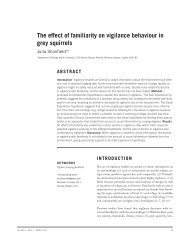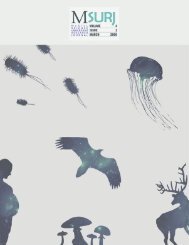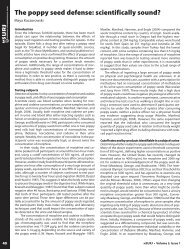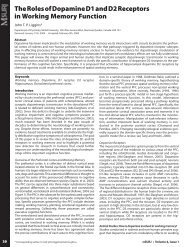the entire issue - McGill Science Undergraduate Research Journal ...
the entire issue - McGill Science Undergraduate Research Journal ...
the entire issue - McGill Science Undergraduate Research Journal ...
You also want an ePaper? Increase the reach of your titles
YUMPU automatically turns print PDFs into web optimized ePapers that Google loves.
RESEARCH ARTICLE<br />
Studying a poxvirus gene capture model<br />
through recombination and reactivation<br />
Ka<strong>the</strong>rine T. Johnson 1 *, Dr. David H. Evans 2,3<br />
1<br />
Department of Microbiology and Immunology, <strong>McGill</strong> University, Montreal, QC<br />
2<br />
Department of Medical Microbiology and Immunology, University of Alberta, Edmonton, AB<br />
3<br />
Li Ka Shing Institute of Virology, University of Alberta, Edmonton, AB<br />
*Email Correspondence:<br />
ka<strong>the</strong>rine.johnson@mail.mcgill.ca<br />
Keywords<br />
Poxvirus: Large double-stranded<br />
DNA viruses, which infect both vertebrates<br />
and invertebrates.<br />
Vaccinia (VACV): Poxvirus famously<br />
used to vaccinate humans against<br />
smallpox. Vaccinia virus is <strong>the</strong> most<br />
widely used model in poxvirus<br />
research.<br />
Recombination: The breaking and<br />
rejoining of genetic material to create<br />
new combinations of genetic traits.<br />
Homology: Sequence similarity<br />
between two (or more) DNA, RNA, or<br />
protein molecules.<br />
Titer: Concentration of infectious<br />
virus expressed in plaque forming<br />
units per mL (PFU/mL).<br />
Abstract<br />
Introduction: Vaccinia poxvirus (VACV) is a double stranded DNA virus that replicates in <strong>the</strong> cytoplasm<br />
of infected cells. Some VACV genes resemble homologs of host genes and appear to have been captured<br />
from <strong>the</strong> cell; however, since poxviruses are confined to <strong>the</strong> cytoplasm, researchers are unclear as to how<br />
<strong>the</strong>se viruses acquire this homology (1). If a cellular mRNA was accidentally reverse transcribed into cDNA,<br />
which could occur during retrovirus co-infection, a poxvirus might be able to incorporate this sequence<br />
into its own genome through rare non-homologous (homology-independent) recombination.<br />
Methods: We modeled this process using two different recombination systems and substituted a DNA<br />
encoding mycophenolic acid (MPA), a selectable marker, for <strong>the</strong> hypo<strong>the</strong>tical non-homologous host cDNA.<br />
We prepared DNA constructs containing this marker along with 20 base pairs homologous to <strong>the</strong> 5’ and 3’<br />
flanking regions of <strong>the</strong> VACV-encoded NotI restriction site. A construct without this flanking homology<br />
was also prepared. The “passive” recombination system used a helper poxvirus to reactivate VACV DNA;<br />
in contrast, VACV infected BSC40 cells were transfected with <strong>the</strong> construct in <strong>the</strong> “active” recombination<br />
system.<br />
Results: The “passive” recombination system generated 105 PFU/mL of reactivated VACV; however,<br />
no recombinants containing <strong>the</strong> selectable marker were detected. The “active recombination” method<br />
generated 106 PFU/mL of total VACV and approximately 10 PFU/mL of recombinant virus for both<br />
homology containing and non-homology containing constructs.<br />
Discussions: We were unable to determine <strong>the</strong> recombination frequency of <strong>the</strong> “passive system” because<br />
recombinant virus was not detected. Based on virus titers determined from plaque assays, we approximated<br />
<strong>the</strong> recombination frequency of <strong>the</strong> “active system” to be ≤ 10-5. We are currently cloning and sequencing<br />
viruses resulting from non-homologous recombination to determine where <strong>the</strong> MPA marker is located.<br />
Preliminary analysis of <strong>the</strong>se types of clones (data not shown in this paper) suggests that <strong>the</strong> transfected<br />
DNAs are being incorporated into a diversity of sites, some located near <strong>the</strong> boundary of <strong>the</strong> VACV genome<br />
where <strong>the</strong> right terminal inverted repeat begins. In summary, our findings suggest that <strong>the</strong> recombination<br />
frequencies in both methods are very low and better methods of selection are needed to observe <strong>the</strong>se<br />
rare events. Future studies of recombinant clones are needed to gain a better understanding of this nonhomologous<br />
gene capture process.<br />
Introduction<br />
Poxviruses are large double stranded DNA viruses that replicate<br />
solely in <strong>the</strong> cytoplasm of infected cells. VACV was famously used<br />
to vaccinate against smallpox and is very commonly used in poxvirus<br />
research. VACV and o<strong>the</strong>r members of this family encode all of<br />
<strong>the</strong> enzymes required for viral replication, including DNA replication<br />
and transcription. Genetic analysis of VACV and o<strong>the</strong>r poxviruses<br />
has revealed sequences that appear to have cellular origins (1). Over<br />
<strong>the</strong> course of thousands of years, <strong>the</strong>se viruses presumably captured<br />
18<br />
<strong>McGill</strong> <strong>Science</strong> <strong>Undergraduate</strong> <strong>Research</strong> <strong>Journal</strong> - msurj.mcgill.ca









